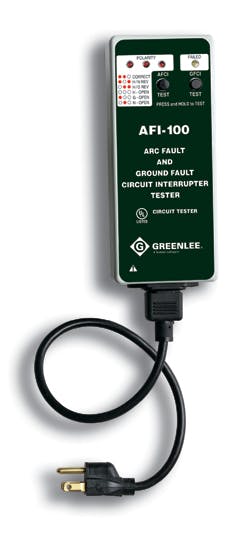Arc Fault/Ground Fault Tester Can Take the Heat
The 2002 NEC implemented new requirements to help reduce the number of electrical fires caused by parallel arc faults in branch circuit wiring. All branch circuits supplying bedrooms in single-family and multi-family bedrooms must now be protected by an arc fault circuit interrupter (AFCI). More electricians are installing AFCIs to comply with the Code, but up until now, neither the installer nor the inspector had any means available to properly test the devices. But all that has changed now that John Grant, owner of DeKalb, Ill.-based Fox Meter, invented the first UL Listed arc fault/ground fault tester.
The AFI-100, now offered by Greenlee, can provide pass/fail verification on AFCIs and GFCIs at the touch of a button. Grant started developing the tester after talking to an inspector who was checking out an addition to his 3-yr-old home. After finding out that Grant owned an industrial, aerospace, and military instrumentation company, the inspector told him about the new requirement for AFCIs. In four months, Grant developed a method of reliably tripping the AFCIs without overheating the tester.
After discovering a way to trip the units, he sent the testers to electrical inspectors across the country. He immediately received positive feedback and submitted 18 units to UL for drop, impact, and heat testing. UL was in the process of finalizing the specifications for arc fault testers at the same time that Fox Meter was developing the product. UL granted approval to the product in October, but requested that a pulsed 5A ground test feature also included in the unit be removed.
“UL didn't want to do any ground testing on arc fault breakers,” Grant says. “If there was a wiring problem, there was a potential hazard. Somebody could get a nasty shock.”
Since a ground test was no longer an option, the inspectors advised Grant to include a GFCI test so they could perform two types of testing with one piece of equipment.
After his product gained UL approval, Grant listed it on a Web site called ArcFaultTester.com. Greenlee, which had been monitoring the Web site, called Grant immediately. Chera Ellis, senior product manager, says it was the first tester to get UL approval. Ellis says Greenlee selected Fox Meter's tester because it can simulate parallel arcing between line and neutral to test 15A and 20A AFCIs in residential applications. Before the AFI-100, there was no way to verify the performance of an AFCI, says Richard Duke, senior electrical engineer for Greenlee.
“These breakers have a little test button that tells the breaker, ‘Pretend there's an arc, now open up,’” he says. “Our device actually produces the same current that you would have in a real arcing situation.”
The tester provides pass/fail verification on AFCI and GFCI receptacles and breakers. To get a visual indication of pass/fail, an electrician can plug the tester into an outlet, verify the wiring, and press a button.
“A lot of our end-users are large contractors, and much of the interest has come from building inspectors who are doing multi-family dwellings,” Ellis says. “They need a unit that can handle repetitive testing without worrying about the heat that's generated or the unit not working correctly.”
Now inspectors no longer have to worry if these devices will operate as designed. Instead, they can use a handheld instrument to safely and reliably test for an arc fault.
For more information, visit www.greenlee.textron.com.
PRODUCT SPECS
Features
-
LED indicators signal correct wiring, open ground, open neutral, hot/ground reversed, and hot/neutral reversed.
-
One-button testing.
-
Microprocessor-controlled precision circuitry.
-
Impact-absorbing housing for extra durability.
-
Powered by the outlet under test; doesn't require batteries.
-
Listed to UL 1436, “Outlet Circuit Testers.”
-
Lifetime limited warranty.
Specifications
-
Arc Fault Test: 12, 112A pulses
-
Pulse Width: 400 µsec
-
Repetition Rate: 120 Hz
-
Ground Fault Test: 7 mA at 120VAC
-
Polarity Indicator: 3 LEDs indicate proper wiring to outlet under test
-
Power: 120VAC, 15A or 20A branch circuit
